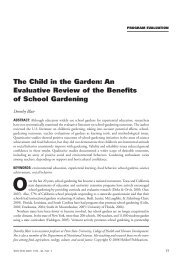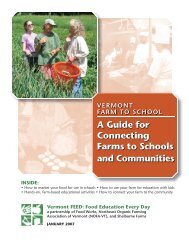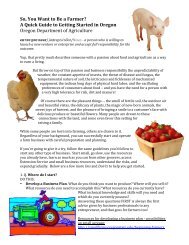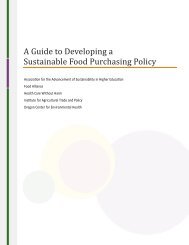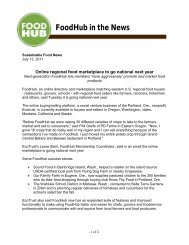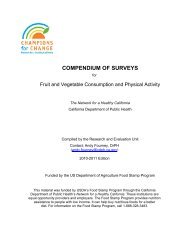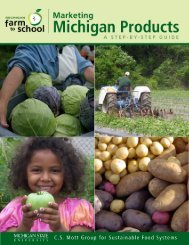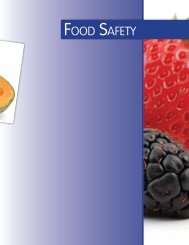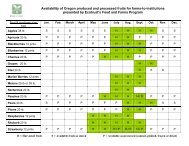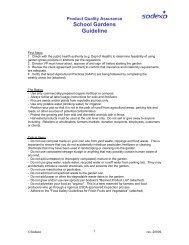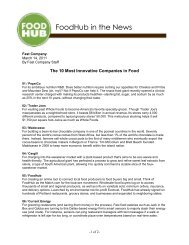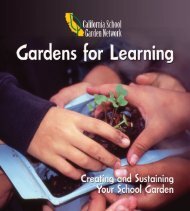eval report cover.indd - New Jersey Farm to School Network Wiki
eval report cover.indd - New Jersey Farm to School Network Wiki
eval report cover.indd - New Jersey Farm to School Network Wiki
Create successful ePaper yourself
Turn your PDF publications into a flip-book with our unique Google optimized e-Paper software.
COM-CA: COMPTON UNIFIED SCHOOLDISTRICT (CUSD), CALIFORNIAConclusions <strong>Farm</strong> <strong>to</strong> <strong>School</strong> and RecommendationsProgram ProfilesThe COM-CA <strong>eval</strong>uation focused on the efforts <strong>to</strong> increasestudent consumption of fruits and vegetablesthrough farm fresh salad bars. Th e program <strong>eval</strong>uationwas led by the University of California Sustainable AgricultureResearch and Evaluation Program (UC SAREP) withsupport from the Center for Food & Justice at OccidentalCollege.CUSD is a Provision 2 school district where all students areprovided school meals free of charge. Th e reach and impac<strong>to</strong>f a farm <strong>to</strong> school program was thus potentially more significantsince all students ate in the cafeteria. CUSD begantheir farm fresh salad bar program by opening five salad barsin elementary schools in the spring of 2004. In the 2004-05school year, Tracie Thomas, the CUSD Salad Bar Coordina<strong>to</strong>r,opened salad bars in the remaining 19 elementary schools,for a <strong>to</strong>tal of all 24 elementary schools. <strong>School</strong>s offered thesalad bars every day as a USDA fully reimbursable meal andas an alternative <strong>to</strong> the hot lunch. District-wide data wascollected for some aspects of the farm <strong>to</strong> school program. Amore detailed comparison of two salad bar schools, Willard and Caldwell, with two non-saladbar schools, Clin<strong>to</strong>n and McKinley, was conducted <strong>to</strong> gain insights on the impacts of the saladbars on produce purchases, financial viability, meal participation, and consumption patterns.Methodology for data collection:►►►►►Comp<strong>to</strong>n Unified<strong>School</strong> District, CAFree / reduced mealeligibility: 95.2%Total schools: 40Enrollment: 30,233Demographics:72.3% Hispanic, 25.9%African-AmericanLocal product used in:Salad bars as USDAreimbursable mealOther programcomponents: In-classnutrition education, saladbar etiquette trainings, farm<strong>to</strong>urs, farmer in the classroom<strong>School</strong> District Produce Purchases: Monthly data on <strong>to</strong>tal fruit and vegetable purchasesfor the district and for four study schools collected from invoices and year-end budgets.Student Participation: Meal participation rates collected on a monthly basis for salad barand non-salad bar schools.Student Food Choices: (a) Food service daily production records collected <strong>to</strong> analyze thenumber of servings of fruits/vegetables per student in two or three sample months fortwo salad bar/hot lunch schools and one non-salad bar school. (b) Took digital pho<strong>to</strong>s ofschool lunches, comparing hot lunch and salad bars at two salad bar schools.<strong>School</strong> Food Service Fiscal Feasibility: Analysis of school food service budgets for fourstudy schools for the 2004/05 school year <strong>to</strong> determine the costs and feasibility of maintaininga salad bar program.Challenges/Lessons Learned: Interviews with key stakeholders, including the salad barcoordina<strong>to</strong>r, the food service direc<strong>to</strong>r, kitchen personnel, and teachers/principals <strong>to</strong> learnabout their experiences in implementing the program and what solutions were developed.Data from this project was available for one year, which was somewhat useful, but insufficientfor making broader interpretations. Unfortunately, the <strong>Farm</strong> Fresh Salad Bar program at CUSDwas discontinued after a year of implementation, though associated nutrition education activitiesthrough the California <strong>Network</strong> for a Healthy California continue at the school sites.Feenstra Gail and Ohmart Jeri, UC Sustainable Agriculture Research & Education Program, Final Evaluation Report,Comp<strong>to</strong>n <strong>Farm</strong> <strong>to</strong> <strong>School</strong> Demonstration Project, July 1, 2004- June 30, 2005.66 Bearing Fruit: <strong>Farm</strong> <strong>to</strong> <strong>School</strong> Evaluation Resources and Recommendations



